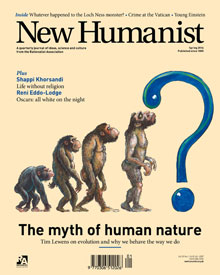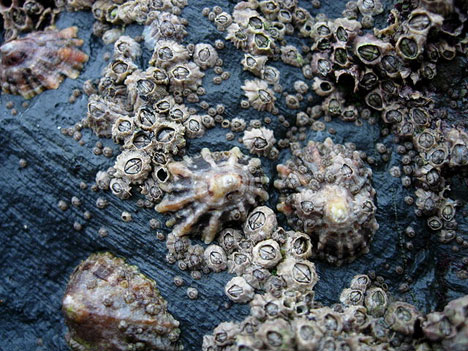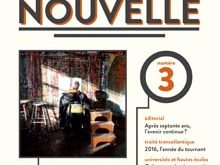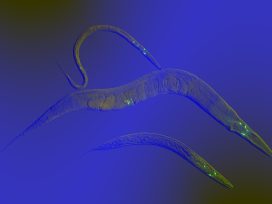
“What”, asked the distinguished evolutionist Michael Ghiselin in 1997, “does evolution teach us about human nature?” The answer he gave will surprise those who suppose that the evolutionary sciences describe the deepest and most ubiquitous aspects of our psychological makeup. Ghiselin informed his readers that evolution “teaches us that human nature is a superstition”. Why would anyone say such a thing? Doesn’t talk about human nature amount to talk about the ways we are all the same? What could be objectionable about that? We can begin to understand the problems if we look back 180 years.
On 2 October 1836, HMS Beagle landed at Falmouth. She had finally returned to England, after a five-year circumnavigation of the globe. One of the Beagle’s passengers was a 27-year-old Charles Darwin. After disembarking he first went to stay at his father’s house in Shrewsbury, but by March of 1837 he had moved to London. It was here that Darwin began to speculate in a series of notebooks on a wide range of topics in natural history and beyond. He formulated his “transmutationist” view of how species had come into existence, he pointed to intense struggle as the primary agent of change in the natural world, and he reflected openly on the impact this image of life’s history might have for human psychology, morality and aesthetic sensibilities. Many of these notebook jottings were transformed, in 1842, into a short “sketch” of Darwin’s theory. By 1844 that short sketch had expanded into a 230-page statement of the evolutionary view. But it was not until 1859 – 15 years later – that the Origin of Species was published. What had Darwin been doing in the meantime?
The answer is that he spent the eight years between 1846 and 1854 working on a gigantic study of barnacles. This period – sometimes referred to as a “delay”, as though Darwin was ready to publish the Origin in the mid-1840s, but somehow lost his nerve – was a puzzle to historians for some time. But it now seems clear how Darwin used his barnacle work as a detailed empirical testing ground for many of his earlier theoretical speculations. One of the most important lessons Darwin took from his meticulous study of barnacle anatomy concerned the ubiquity of variation: “Not only does every external character vary greatly in most of the species”, he wrote, “but the internal parts very often vary to a surprising degree”. He went so far as to assert that it is “hopeless” to find any part or organ “absolutely invariable in form or structure”.

Barnacles and limpets compete for space in the intertidal zone, near Newquay, Cornwall (England). Could it be that our perceptual capacities are subject to the same variation that Darwin saw in barnacles? Photo: Mark A. Wilson. Source: Wikimedia
Variability in all parts of all species is a primary fact of nature, says Darwin, and this ubiquitous variation is the fuel that powers natural selection. It is the conviction, inherited from Darwin, that species vary in all respects at any moment in time, and that natural selection causes those species to change in profound ways over time, that has made the likes of Ghiselin so sceptical of the thought that species have “natures”.
Evolutionists are not, however, united in their rejection of “human nature”. The eminent evolutionary psychologists Leda Cosmides and John Tooby announced back in 1990 their intention to defend “the concept of a universal human nature”, and Stephen Pinker’s 2002 book The Blank Slate: The Modern Denial of Human Nature implies through its title that the deniers of human nature are misguided. But even more recent work – especially an important and widely discussed article by the evolutionary anthropologist Joseph Henrich and his colleagues, from 2010 – demonstrates that evolutionary thinkers are increasingly placing stress on how cultural differences drive human psychological variability, often in the most surprising quarters.
Henrich et al point out that the vast bulk of psychological research is done in universities in places like North America, Australia and western Europe. That means that when researchers are looking for experimental subjects, they typically rely on students from those universities. The result is that we know a lot about the psychology of people in what Henrich and co call “WEIRD” societies: those that are Western, Educated, Industrial, Rich and Democratic. But they move on to argue that just because WEIRD subjects’ minds work in a certain way, it by no means follows that all – or even most – human minds work like that.
Henrich et al illustrate their case with multiple examples. One of them concerns human responses to what psychologists call the Müller-Lyer illusion. Look at these two lines:

Most readers of this essay are likely to see the top line as longer than the bottom one, even though in fact their lengths are identical. But travel the world, and you will find that not all people are as susceptible to the illusion as this magazine’s WEIRD readers. As long ago as 1901, the Cambridge physiologist and anthropologist W.H.R. Rivers found that the students he tested in Cambridge seemed far more vulnerable to the illusion than the Murray Islanders whom he tested during his expedition to the Torres Straits. Henrich et al report a rather more recent study from the 1960s by Marshall Segall and others, who found that San foragers of the Kalahari desert in southern Africa did not see the two lines as having different lengths at all. It is still not clear why people vary in their response to the Müller-Lyer illusion. Segall and colleagues suggested susceptibility was due to being brought up in environments full of clean edges and straight lines. But the fact of variation is well established.
Another study from 2007 by Jonathan Winawer and co-workers indicates that human colour vision, or at least our ability to judge differences in colour between different surfaces, may be also affected by how we are raised. In English we have a general term for blue, and we distinguish between light and dark shades. Russian speakers instead have two entirely unrelated terms – goluboy for what we call “light blue”, and siniy for what we call “dark blue” – and no overarching term that corresponds to any more general category of “blue”. The availability of these sharply different colour terms allows Russian speakers to make discriminations more quickly than English speakers when presented with two patches of colour that lie across thegoluboy/ siniy (light blue/dark blue) boundary. All of these studies show that even our perceptual capacities are subject to the same variation that Darwin saw in his barnacles.
Modern biologists do not remotely agree on how to define what a species is. But they do agree that it is mis- leading to ask, “What sort of anatomical, physiological, mental or behavioural features must an organism have for it to be considered a member ofHomo sapiens?” Darwin’s insistence on the ubiquity of variation within species has led most modern biologists to understand species not as groups of organisms with internal and external properties in common, but instead as twigs on the tree of life. Species are segments of the great genealogical nexus. What matters for species membership – that is, what it takes for an organism to be a member of a species such as Canis familiaris (the domestic dog), or Homo sapiens – is determined by genealogical relations. Just as membership of the Royal Family is decided by who one’s parents are, rather than by one’s internal or external bodily features, so membership of a larger genealogical unit like a biological species is also settled by appeal to ancestry. If “human nature” is supposed to pick out a set of traits that define what it is to be human, then human nature is a myth.
But does the presence of variation really show, as Ghiselin would have us believe, that human nature is a superstition? Or have we simply been too demanding in our conception of what human nature is supposed to be? It is hardly news that humans differ in terms of how they see colours. We have known about colour-blindness for centuries. Even so, the great majority of humans have three classes of cone cell in their retinas, and are free of colour-blindness because of this. What is more, there is a plausible evolutionary story to be told about why this “trichromatic” form of vision emerged: my Cambridge colleague John Mollon has argued that it was favoured by natural selection because it enabled our primate ancestors to detect ripe fruits against a dappled, leafy background. Biologists these days do not feel the need to find any catalogue of properties that are uniquely found in all and only humans. But this leaves alive the thought that some properties – psychological and physical – are present in almost all humans, and that evolutionary processes explain why those properties became and remain so prevalent in our species. Perhaps that is all we mean when we say that colour vision is a part of human nature, and, if that is all we mean, who could deny human nature’s reality?
One problem that arises from defining human nature as a set of features common in our species due to evolutionary processes is that it is scientifically arbitrary. Variability can sometimes be actively maintained by natural selection. The marine crustacean species Paracerceis sculpta gives us a nice example. The males of this species come in three quite different types, with different body shapes and different behaviours. The large male type guards “harems” of females within sponges. Another much smaller, faster male type darts into the sponges to grab mating opportunities when it can. And a third male type looks just like the females, and sneaks into the sponges to mate in disguise. No one form dominates over the others, and natural selection maintains all three. So while natural selection might sometimes make a single “design” more or less omnipresent in a species, this is only one potential result of evolutionary processes. Variability is another.
This brings us to a second problem with human nature. Recall that the subtitle Pinker chose for The Blank Slate was The Modern Denial of Human Nature. That suggests that we vindicate human nature to the extent that we are able to show that our minds are not blank slates at birth. In other words, human nature names those traits that are somehow “hardwired” into our psychological or behavioural repertoires. This might seem to be a stylistic variant of the idea that human nature names the traits that more or less all humans possess as part of their evolutionary heritage. After all, what difference is there between pointing to “hardwired” traits and “evolved” traits?
There is a big difference. Consider the capacity to imitate: to observe the actions of other humans, and copy those actions. Imitation is highly developed in humans. Very few other species have the capacity to imitate, and some evolutionists have suggested that our accentuated ability to imitate may help to explain why humans are so much better than other species at producing increasingly refined tools, traditions and bodies of knowhow. So the capacity to imitate is one that is present in an especially acute form in humans. It is found in all human societies, and it seems to have been of enormous importance in explaining our technological and behavioural development over thousands of years. For all those reasons it sounds like a good candidate for being part of human nature. But the psychologist Cecilia Heyes, while accepting much of this, has been arguing for some years that the capacity to imitate is something that human babies acquire by learning. If she is right, it is not “hardwired”.
There is a puzzle in explaining how the capacity to imitate is acquired. An imitator needs to observe an action in another person, and then produce a similar one. The problem is that how an action looks to an observer does not resemble how it feels for someone executing it. The puzzle is especially acute when one’s own bodily movements are hard to observe. If a baby sees me contorting my face in a certain way, how is she able to copy that action? She cannot look at her own face to check on how it is moving, and the feel of her own face moving does not resemble the look of my own face moving in the same way.
Heyes thinks that learning helps to explain this puzzle. Links between perception of an action and execution of the same action can be learned, so long as perception and execution are fairly reliably associated. They can come to be associated in part because individuals can sometimes look at their own actions (they can observe their own hands), in part through the use of artificial supports such as mirrors (sometimes we really can see our own faces), in part through witnessing action patterns in others when one is part of a group engaged in common tasks, and so forth.
Heyes’s view is not accepted by all, but it does have empirical backing. It helps to explain that chimpanzees can be trained to imitate, that birds seem able to imitate behaviours that they engage in collectively as flocks, that imitation in newborn human infants – except with respect to tongue protrusion – takes time to emerge, and so forth. Imitation is just the sort of trait that one would presumably want to count as natural, and yet its adaptive development appears to rely essentially on cultural influence.
So human nature is a confused concept, because it blurs a number of distinctions we should try to keep in sharp focus, such as the distinction between traits that are important for our species’ distinctive evolutionary trajectory, traits that are ubiquitous in our species, and traits that are “hardwired” into our brains. Is there any evidence, though, that the notion of human nature can do any harm?
Many of us find it hard not to think in terms of human nature and the natures of other species. Psychological research done by a variety of scientists including Scott Atran and Susan Gelman suggests that this tendency emerges early in the lives of young children. Four-year-olds tend to think that each species has an internal “essence” which drives the development of that species’ typical features. So children think that all dogs possess a “doggy” essence, which results in standard “doggy” behaviours and appearances – waggy tails, barking, energetic running about and the like. They also believe these essences can misfire: this might result in an individual dog which refuses to wag its tail. Of course, modern biology denies that these essences are real, so the research reveals a widely shared error in our intuitive ways of thinking about animals and plants.
This approach to the nature of species begins to look more sinister in the light of Gelman’s more recent research, which indicates that we do not only think of biological species as having hidden essences. We also tend to think, erroneously, of course, that races have internal essences. Although Darwin claimed to see variation everywhere, he was as prone as the next Victorian to sweeping generalisations about the nature of “the negro” or “the Australian”, and he endorsed his contemporary William Greg’s description of “the careless, squalid, unaspiring Irishman”. This kind of essentialist thinking is hard to correct with observational evidence. If internal essences can regularly “misfire”, then it will be hard to persuade someone that there is no essential “doggy” nature merely by pointing to individual dogs that abhor chasing after sticks. And it will also be hard to persuade someone of the error of thinking there is an underlying Irish essence, merely by demonstrating how many individual Irishmen are full of application and ambition. It is here that talk of what we owe to our “natures” becomes not just misleading but harmful. These supposed “essential natures” arguably underlie damaging and persistent racist and sexist stereotypes.
Appeals to what is natural, as well as appeals to the nature of the human species, sometimes appear in conservative arguments against the use of new reproductive technologies. Michael Sandel, a highly respected philosopher, has appealed to what is “natural” in his case against so-called “enhancement” technologies. These are technologies of different kinds – they might involve drugs, prostheses or genetic alteration – that promise to augment human abilities beyond the norm required for good health. Questions of the morality of enhancement are once again in the newspapers these days, because of the proposition that new “genome editing” technologies such as the CRISPR-Cas9 technique might someday be used not only for controlling inherited diseases but potentially for introducing genes with additional non-therapeutic benefits into the human germline. In an article in Nature earlier this year, a group of scientists working on these techniques cautioned that “Many oppose germline modification on the grounds that permitting even unambiguously therapeutic interventions could start us down a path towards non-therapeutic genetic enhancement. We share these concerns”.
Sandel’s case against enhancement draws on the idea that we need to think of children as “gifts”. Parenthood, he says, teaches the importance of “openness to the unbidden”, and it restrains “the impulse to mastery and control”. That is why, says Sandel, we shouldn’t intervene in what nature presents us with when we conceive and raise children. The problem with this way of opposing enhancement is that it seems to have the result that in addition to rejecting the prospect of “designer” babies, augmented beyond the healthy norm with genome editing techniques, we should also refuse to correct congenital diseases. Doesn’t this, too, represent an effort to “master” what nature has given us? Sandel rejects that interpretation of his argument. He argues that “To appreciate children as gifts or blessings is not to be passive in the face of an illness or disease. Healing a sick or injured child does not override their natural capacities but permits them to flourish”.
This sounds reasonable, until we ask ourselves how we are supposed to tell the difference between capacities that are “natural” to humans, and capacities that are instead the result of over-ambitious distortions of those natural capacities. Consider someone born with the disease phenylketonuria (PKU). Left untreated, this disease leads to severe learning and behavioural difficulties. Fortunately, its detrimental effects can be eased significantly if the growing child is given a special diet, low in the commonly-occurring amino acid phenylalanine, from birth onwards. Have we overridden the child’s natural capacities by giving her a special diet? Presumably Sandel wants to count this as allowing her natural capacities to flourish. But then it becomes hard to see what one might understand by a person’s “natural capacities”, unless we simply mean to pick out all the capacities that person might possibly attain, if only they had access to suitable medical, technical and cultural interventions.
We have now opened ourselves up to the thought that an individual’s “natural capacities” include the enhanced capacities she might attain if only she had access to genome editing. In desperation one might say that genome editing is not itself a “natural” process, hence one cannot describe it as allowing a person’s natural capacities to flourish. Genome editing is, after all, a considerable technical achievement. But it is equally implausible to think that the provision of an artificial diet, low in phenylalanine, is “natural” in that sense. Appeals to what is natural or unnatural are of no use if we want to build a case against genome editing. Nature cannot do the ethical work intended for it.








